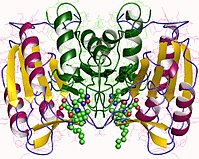
Photo from wikipedia
Objective Intra-tumoral expression of the serine hydrolase carboxylesterase 2 (CES2) contributes to the activation of the pro-drug irinotecan in pancreatic ductal adenocarcinoma (PDAC). Given other potential roles of CES2, we… Click to show full abstract
Objective Intra-tumoral expression of the serine hydrolase carboxylesterase 2 (CES2) contributes to the activation of the pro-drug irinotecan in pancreatic ductal adenocarcinoma (PDAC). Given other potential roles of CES2, we assessed its regulation, downstream effects, and contribution to tumor development in PDAC. Methods Association between the mRNA expression of CES2 in pancreatic tumors and overall survival was assessed using The Cancer Genome Atlas. Cell viability, clonogenic, and anchorage-independent growth assays as well as an orthotopic mouse model of PDAC were used to evaluate the biological relevance of CES2 in pancreatic cancer. CES2-driven metabolic changes were determined by untargeted and targeted metabolomic analyses. Results Elevated tumoral CES2 mRNA expression was a statistically significant predictor of poor overall survival in PDAC patients. Knockdown of CES2 in PDAC cells reduced cell viability, clonogenic capacity, and anchorage-independent growth in vitro and attenuated tumor growth in an orthotopic mouse model of PDAC. Mechanistically, CES2 was found to promote the catabolism of phospholipids resulting in HNF4α activation through a soluble epoxide hydrolase (sEH)-dependent pathway. Targeting of CES2 via siRNA or small molecule inhibitors attenuated HNF4α protein expression and reduced gene expression of classical/progenitor markers and increased basal-like markers. Targeting of the CES2-sEH-HNF4α axis using small molecule inhibitors of CES2 or sEH reduced cell viability. Conclusions We establish a novel regulatory loop between CES2 and HNF4α to sustain the progenitor subtype and promote PDAC progression and highlight the potential utility of CES2 or sEH inhibitors for the treatment of PDAC as part of non-irinotecan-containing regimens.
Journal Title: Molecular Metabolism
Year Published: 2021
Link to full text (if available)
Share on Social Media: Sign Up to like & get
recommendations!